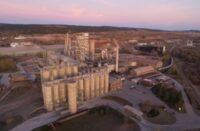Your recent “Trowel and Error” column about polished concrete (February/ March 2011) offered a helpful overview of densifier chemistry, summarizing the three most familiar options. Unfortunately, you left out the fourth, newest technology: colloidal silica, which offers several advantages for applicators and the environment.
You suggested that it’s important to understand the chemistry of densification and the function it serves. Densifiers are silica-based solutions that react with lime (calcium hydroxide) in concrete. Portland cement paste can contain up to 25 percent lime. The reaction forms calcium silicate hydrates (CSH), the same type of compounds formed by cement hydration. The additional CSH fills microscopic pores in the concrete, increasing hardness and decreasing the ability of liquids to penetrate and stain.
Increased hardness means abrasion resistance. It also makes concrete more polishable. Generally, the harder a material is, the better it will take a shine.
The difference in densifiers is how the silica gets delivered and bound to the concrete. Silicates (sodium, potassium, and lithium silicate) are compounds of mineral salts and silica. They are caustic, in the pH range of 10.5 to 12.5, similar to lime itself. Colloidal silica is virtually pure nanoscale silica suspended in water. It is more efficient at a basic chemical level.
When silicates react with lime, residues of the mineral salts are left behind. These residues can become the hard, discoloring surface deposit known as “whiting.” It’s the bane of polishers that can only be removed by regrinding the floor. Sodium and potassium silicates must be scrubbed off the concrete to avoid whiting. The residues often require costly hazardous waste disposal. Lithium silicate can also leave whiting if overapplied (which sometimes tempts applicators to underapply it, at the risk of not adequately densifying the concrete).
Colloidal silica, by comparison, contains less than 0.5 percent metallic salts, eliminating the inherent whiting problem of silicate densifiers. My company makes a colloidal silica densifier, Lythic Densifier, that is spray-applied for about 15 minutes — the same speed of application as lithium silicate. After drying for about an hour, the slab is ready for polishing. There is no removal step. A small amount of dry powder residue gets vacuumed up during polishing.
Colloidal silica has two other distinctive properties. First, it is less caustic than silicates — between 8 and 9.5 pH — making it safer to handle.
Second, colloidal silica bonds to other silica, including to itself. It can build up surface density with additional applications — applicators have reported rescuing soft and damaged slabs with it. It bonds to silica in cementitious overlays like Mapei Ultratop and Rapid Set TRU. These overlays are made from specialty cements that produce less lime than portland cement. Without lime, silicates cannot react and can fail to make the overlay polishable. Colloidal silica also makes possible colloidal silica-based stain protectors and cleaners that enhance the floor as they work.
Colloidal silica has a six-year track record of use in the field, and it is an option worth consideration. In a word, we deliver efficiency. More efficient chemistry leads to a more efficient densification process. — David Loe, president, Lythic Solutions












